The Clear Banner sub-blog on Jihadology.net is primarily focused on Sunni foreign fighting. It does not have to just be related to the phenomenon in Syria. It can also cover any location that contains Sunni foreign fighters. If you are interested in writing on this subject please email me at azelin [at] jihadology [dot] net.
—
A Brief Update On Ethnic Georgian Foreign Fighters In The Islamic State
By Bennett Clifford
Background
In 2015, the government of Georgia estimated that 41 of its citizens were active combatants in jihadist groups in Syria and Iraq, while other reports suggest that the contingent may have been as large as 100.1 The bulk of the foreign jihadist fighters from Georgia originated from the Pankisi Valley, an isolated set of villages in the north-east of the country that is renowned as a source of prominent foreign fighters, including the Islamic State (IS)’s deceased minister of war, Tarkhan Batirashvili (Umar al-Shishani).2 The majority population in the Pankisi Valley are Kists. Related closely to the Chechens of the North Caucasus, the Kists maintain distinct religious traditions, customs, folk laws (adat-tsesebi), and a unique dialect of the Chechen language.
Most of Georgia’s foreign fighters in Syria and Iraq are ethnic Kists from the Pankisi Valley, but the second largest demographic are ethnic Georgian Muslims.3 A database maintained by the author includes eight ethnic Georgians who successfully traveled to Syria and Iraq to join ISIS. Unlike in the Pankisi Valley, where foreign fighter recruitment is geographically consolidated, ethnic Georgian fighters come from various settlements and villages throughout the country. During Soviet rule in Georgia, particularly during its twilight years, ethnic Georgian Muslims living in the high mountainous communities of the south-western province of Adjara were resettled throughout the country due to a combination of ecological disasters and government planning policies.4 Most of the ethnic Georgian foreign fighters came from these “eco-migrant” settlements: in particular, the villages of Nasakirali and Zoti in the western province of Guria, and particular villages within the Tsalka municipality in the central Kvemo Kartli region.
This brief post covers the reported fates of three members of the ethnic Georgian foreign fighter contingent after the loss of IS territory in Syria and Iraq, revealing new information on their status and whereabouts. Perhaps most importantly, one of the major (and arguably, only) IS Georgian-language propagandists and the group’s standard-bearer, Tamaz Chaghalidze, is ostensibly alive and has returned to social media during the past few months, posting a barrage of new Georgian-language material. These posts glorify the martyred “heroes of the Islamic State,” offer justifications for IS’ losses in the sieges of Mosul and Raqqa, and provide insight on other Georgians in Syria and Iraq. One post, included in full with an English translation below, discusses the fates of two members of the group– Badri Iremadze and Murman Paichadze.
Who is Tamaz Chaghalidze?
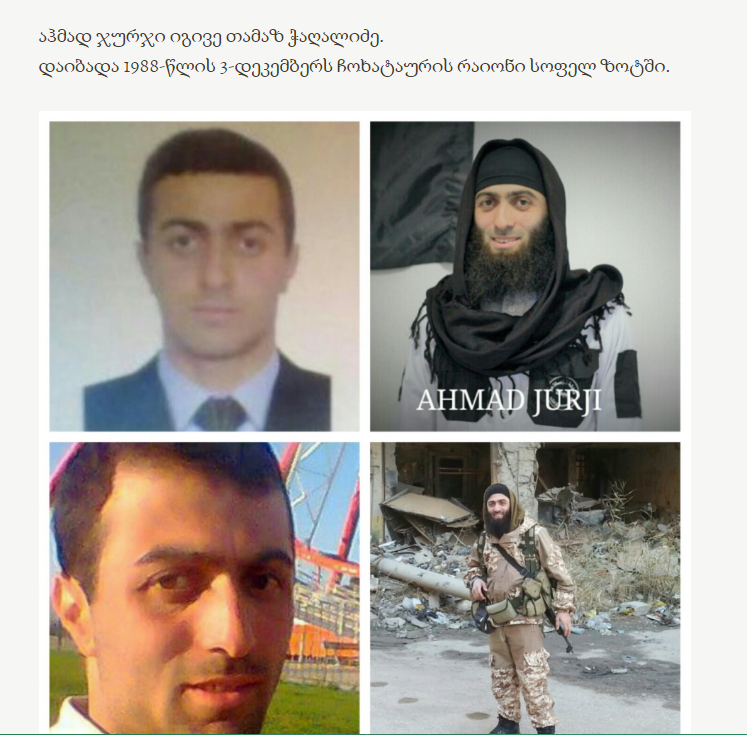
Post from an autobiography on Tamaz Chaghalidze’s WordPress site. “Ahmad Jurji, also known as Tamaz Chaghalidze, was born on December 3, 1988 in the village of Zoti in Chokhatauri municipality.”
Tamaz Chaghalidze (kunya: Ahmad Jurji), largely unknown outside of Georgia, is directly responsible for the majority of IS propaganda in the Georgian language. Born in 1988 in the village of Zoti in the province of Guria, Chaghalidze left for the city of Batumi in Adjara in 2006, where he studied international economics at Shota Rustaveli State University. During his eight years in Batumi, he transitioned from participation as a political operative for a major Georgian party to an active figure in the local Islamist scene, and in 2014, he traveled to Syria to join the jihad.5 As an opening salvo in a flood of propaganda, shortly after his departure to Syria he published a video in August 2014 declaring his allegiance to Abu Bakr al-Baghdadi and threatening Georgia for its mistreatment of Muslims.6
The video reached viral status in Georgia and resulted in the opening of an investigation by Georgia’s State Security Services into Chaghalidze’s threats against Georgia.7 Chaghalidze remained active online, utilizing a still-active Odnoklassiki profile which he opened before his departure to disseminate even more threats. Stylistically, Chaghalidze’s content errs towards self-promotion and directly appeals to ethnic Georgian Muslims, particularly eco-migrants. In many posts, he utilizes Adjaran dialect and slang, punctuating Salafi-jihadist religious teachings with invectives targeting members of the Georgian Orthodox Church, Georgian Muslim institutions, the Georgian armed forces, and others:
“Attention- to the kaafirs in Georgia who did anything against Islam and Muslims as part of NATO missions in Iraq, Afghanistan, Africa,8 or in Georgia itself in Lapanquri,9 Pankisi, Guria, Adjara, Javakheti or other regions. We know all your actions and you will pay for everything with your dirty kaafir blood. I warn you again- do not touch any Muslim brother or mosque or anything that concerns the name of Islam; otherwise, one day, when the black flags fly over Georgia, you will have nowhere to escape. You will beg on your knees, and they will show it on TV programs. You rats will regret the day you were created. We will cause so much trouble for the Patriarchate in Adjara that you robe-wearing rats10 will wish you were created as reptiles. I swear, by Allah, every kaafir will pay with their dirty blood. The one chance that civilians have is to accept Islam and pledge allegiance to the Caliphate.”
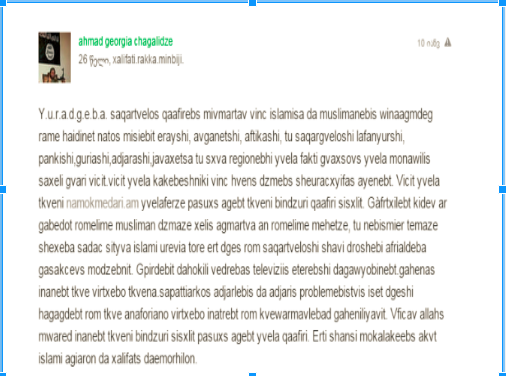
From 2015 until 2017, Chaghalidze maintained an extensive online presence from his base in Syria, running his own personal WordPress blog. In addition, he contributed to several other sites on WordPress, Facebook, Tumblr, Odnoklassiki, Myspace and Telegram entitled “Xalifat” [Caliphate] or “Daula” [The State], and ran multiple sock-puppet Facebook accounts. These pages disseminated efforts by Chaghalidze and other Georgian-speaking foreign fighters to translate official IS media products, such as the magazines Dabiq and Rumiyyah and the al-Bayan radio service, into their native tongue. As part of an ongoing investigation, the Georgian government repeatedly blocked the IP addresses of these pages, shutting off access in Georgia.11 Each time a page was shut down, another appeared in its place. Eventually, many of Chaghalidze’s efforts were consolidated into the group Bushra, which operates a still-active Facebook group, several Telegram channels, a justpaste.it account and uses a TutaNota email address.
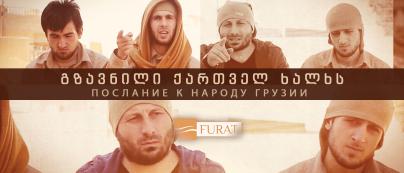
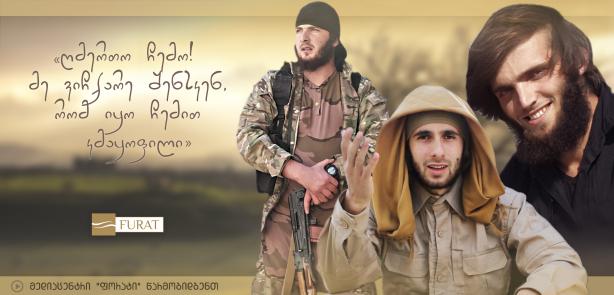
Posters for two official Islamic State releases in the Georgian language- “Message to the Georgian people” (2015, top) and “My God! I hasten towards you so that you would be satisfied with me” (2016, bottom)
Eventually, partially due to the success of Chaghalidze’s efforts in the unofficial realm, IS official media outlets published two releases in the Georgian language. In November 2015, IS’ al-Furat Media Foundation released “Gzavnili kartvel khalkhs” [Message to the Georgian People], its first full-length video in the Georgian language. The 12-minute video featured four ethnic Georgian fighters from Guria and Kvemo Kartli: Khvicha Gobadze (aka Abu Mariam al Jurji), Roin Paksadze, Mamuka Antadze, and Badri Iremadze. The second release, “Ghmerto chemo! Me vichkare shensken, rom iqo chemit kmaqopili” [My God! I hasten towards you so that you would be satisfied with me], was released in February 2016 and featured Chaghalidze, Iremadze, and the Kist fighter Mukhmad Baghakashvili eulogizing three slain Georgian IS fighters. In the second video, Chaghalidze appears in an IS police uniform—elsewhere, on his eponymous WordPress blog, he identified his role in the organization using the Georgian-transliterated Arabic term “idari shurtas”- administrative police.12
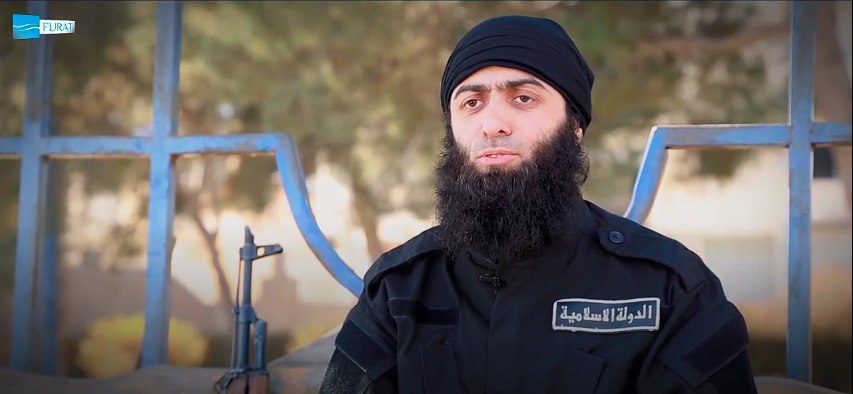
Tamaz Chaghalidze in the February 2016 video “My god! I hasten towards you so that you would be satisfied with me”
In April 2016, Chaghalidze announced the formation of “Vilayat Jurjia,” an unofficial IS province in Georgian territory. His announcement, posted initially on his WordPress site, seemed more of a theoretical exercise than a claim of jurisdiction, but the province was connected to a group of Georgian fighters which he claimed had banded together in the lands of the Caliphate.13 This band of Georgians included both ethnic Georgians and a handful of Kists, including the military commander of several jamaats in Latakia province, Levan Tokhosashvili (Al Bara Pankisi), who at the time had recently defected to join IS. After the siege of Raqqa, Chaghalidze went quiet online for several months, restoring several social media accounts in the early spring of 2018. Today, his exact whereabouts are unknown.
Chaghalidze on other Georgian fighters: where are they now?
In a May 2018 post on a Facebook account identifying itself by Chaghalidze’s kunya and using his image as a profile picture, the poster ponders the status of two of the Georgians who joined IS’ ranks: Badri Iremadze (Abu Yahya al-Jurji) and Murman Paichadze (Abu Asia al-Jurji). Family and friendship ties in Georgia connect all three men. At the time of the siege of Mosul, Iremadze and Paichadze were reportedly in the city, participating in IS’ defense. Chaghalidze claims that both Iremadze and Paichadze were likely killed in Mosul. Although not reported in Georgian media or claimed by the Georgian security services, if Chaghalidze’s report is correct, at least 34 fighters from Georgia have been killed fighting for jihadist groups in Syria and Iraq.14
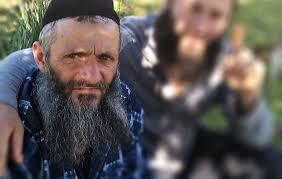
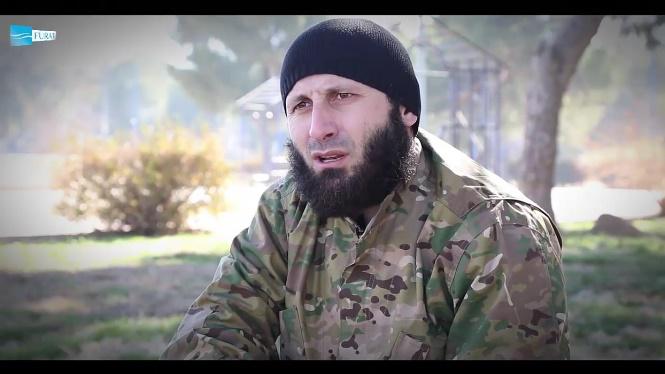
Murman Paichadze (left) and Badri Iremadze (right)
Murman Paichadze was by far the oldest Georgian citizen who is publicly confirmed to have traveled to join IS. The 56-year-old imam of the village Kokhta in the Tsalka municipality left his wife, children, and grandchildren behind to go to the Middle East in 2015, posting a lengthy manifesto on a Georgian-language Salafi website justifying his decision. Paichadze is also a “close relative” of Tamaz Chaghalidze.15 Badri Iremadze, a 32-year-old from the village of Nasakirali in Guria, was working in a tea plantation in Turkey when he departed for IS-held territory.16 He is the only Georgian IS fighter on-camera in both official Georgian-language IS videos.
The May 2018 post claims that there is a 99% chance that both Paichadze and Iremadze were martyred but cannot reach a fully conclusive determination. As a caveat, Chaghalidze has a penchant for exaggeration and his post here passes along hearsay from Iremadze and Paichadze’s families regarding their last points of contact with their family in the Islamic State. Nevertheless, the post represents the first mention of these fighters since they last appeared in news stories and media releases from 2015 and 2016. Days before the publication of the post, the Facebook account on which it appears was deleted and replaced by a new profile bearing Chaghalidze’s picture and several pro-IS posts in Georgian. The post in full, translated into English, is below:
“[I] asked the relatives of Murman Paichadze and Badri Iremadze if they had any information on them. Here is the answer:
Abu [A]sia (Murman) and Abu Yahya (Badri) were both in the town of Mosul during the time that the kaafirs launched their unjust attack. In the first stage, an army of 115,000 with air support, and then later an army of up to 210,000, fought against 6,000 to 7,000 soldiers of the Caliphate. During this fight, after a 10-month siege, the kaafirs took the town of Mosul.
Murman and Badri fought there, and there is information that most of the people there became shahid (inshaAllah): not only the soldiers of the Caliphate, but tens of thousands of women, children, and the elderly living there all died in the brutality that the American coalition and the Shi’a armies brought to the Muslim people. They used all kinds of armaments, including chemical weapons and gas bombs, against everybody.
From what we can tell about the brothers who left Georgia who were there [in Mosul] at that time with their families, nobody made it out. But it’s not possible to say anything definitively, because there’s no exact data on how many people are imprisoned, or how many successfully made it out of Mosul into the deserts surrounding the town, where approximately 1,000 brothers are located now.
It’s also not possible to say anything about their families. I don’t know anything besides the information disseminated by the kaafirs. In some cases, they publish photos of the people who are captured, but we haven’t seen any of their faces. And I don’t know what the children look like. The kaafirs took some of the children who were left behind in Mosul or found in the basements and ruins. So it’s hard to say anything definitive about the people who left Georgia [for Syria] and determine whether they are alive, in prison, or became shahid.
Of course, when I say things like, “they became shahid inshaAllah,” I’m speaking under the assumption that 99% of those who were alive [prior to the siege of Mosul] are no longer remaining [e.g. dead], and for the remaining 1%, we pray to Allah that they are in the desert with the remaining brothers. We pray that they are not in the prisons of the rafida.
We ask Allah for the best option, which is that they became shahid inshaAllah. My sources found out that when the kaafirs took Mosul, they destroyed the city to rubble.17 Two months prior [to the end of the siege], I talked to Abu Asia (Murman), and at that time he was already wounded. He told me, ‘God is great, this is the will of God. If it’s God’s will for us to be under siege, it will be God’s will for us to either be victorious or become shahid. You know that we are here to attain shahadah, and not to take cities, or for other matters of the material world. May God grant us Paradise if He does not will us to hold this land.’
Regardless of the fact that 99% of them likely became shahid (inshaAllah), I still look for them when someone comes from the desert, and I ask around. There was a case where some wounded people and women came from Mosul to Tel Afar before the city fell, but there too, the Turkmens from the local tribes betrayed the Caliphate and the mujahirs by handing the muhajirs and their families to the Peshmerga and the rafida. But maybe it’s possible that someone was in their ranks.
I don’t exclude any possibility based on what I think about the 1%. Only Allah knows best, and if Allah wills that someone will remain alive, it will be the case, as Allah is almighty and all-powerful, praised be He.
A few things that I can say to their families is that you should pray that Allah is satisfied with them, fear Allah, obey Allah and his religion, and avoid the taghut and their path.”
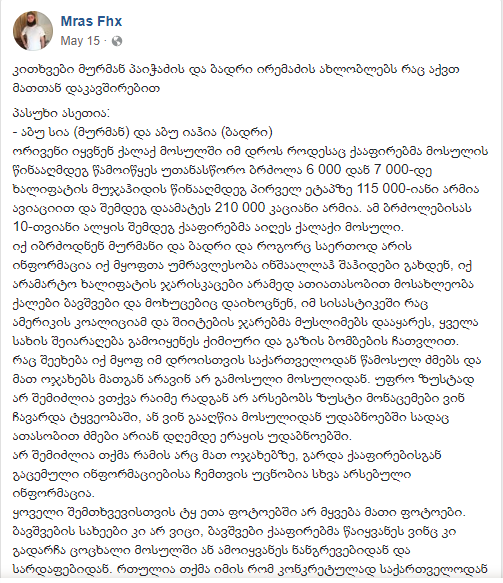
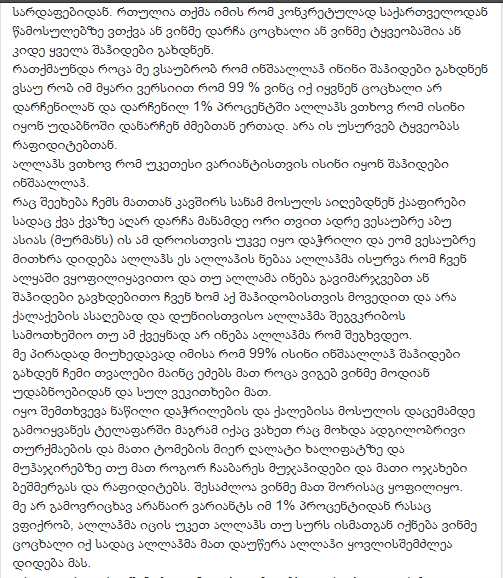

Bennett Clifford studies violent extremist movements and organizations in the Caucasus, Central Asia, and the Balkans, and supporters of extremist groups in the United States for George Washington University’s Program on Extremism.
—
Endnotes:
